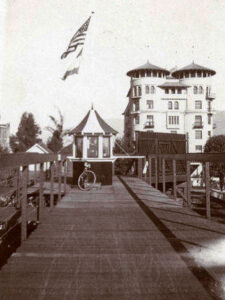Autumn Gear Guide
Find inspiration in our Gear Guide that will keep you out on your bike through wind or rain.
Download NowImagine it’s the dawn of the 20th century. The year is 1900, and Pasadena, California, is poised to usher in a new era of transportation. Among the dusty wagon roads and burgeoning railroads, a dream emerges—a nine-mile elevated cycleway, promising a smooth, swift ride from Pasadena to the heart of Los Angeles. The mastermind behind […]
Imagine it’s the dawn of the 20th century. The year is 1900, and Pasadena, California, is poised to usher in a new era of transportation. Among the dusty wagon roads and burgeoning railroads, a dream emerges—a nine-mile elevated cycleway, promising a smooth, swift ride from Pasadena to the heart of Los Angeles. The mastermind behind this audacious plan is none other than Horace Murrell Dobbins, a local millionaire, and cycling enthusiast. With the cycling boom at its peak, Dobbins envisioned a highway in the sky, dedicated solely to the cyclists of Southern California.
According to an article in Curbed, “in 1897, it was estimated that there were 30,000 bikes in the Los Angeles area alone.”
The California Cycleway, this wooden trestle, painted a pleasing green, was to be the cyclist’s paradise. The cycleway was planned to glide over the oak-studded Arroyo Seco valley, offering a picturesque and dust-free commute for the estimated 30,000 cyclists in Los Angeles County. It was wide enough to accommodate four cyclists side by side, with ample room for another lane if needed. High society was all in, with investors including a former governor of California and the owner of Pasadena’s largest bicycle shop. The cycleway’s opening was celebrated with great fanfare on New Year’s Day, 1900, coinciding with the city’s Tournament of the Roses parade. Hundreds of cyclists, their bikes adorned with flowers, embarked on the inaugural ride, heralding a new era of transportation.
Yet, this visionary project was not to flourish. Only a mile and a quarter of the California Cycleway was completed, a far cry from the planned nine miles. It quickly became apparent that the route was too short to attract enough paying customers, turning the ambitious project into a financial albatross. Despite the promising start, the cycleway struggled to generate the expected revenue. Its limited length and lack of access points rendered it more of a novelty than a viable transportation option. Dobbins had envisioned the cycleway as a bustling artery for commuters and a scenic pathway for weekend riders seeking a retreat to the Sierra Madre and San Gabriel mountains. Instead, it became a costly lesson in the pitfalls of underestimation and over-ambition.

Looking toward Hotel Green (circa 1904)
The cycleway’s decline was hastened by a bitter dispute with railroad magnate Henry E. Huntington, whose Pacific Electric railroad company viewed the cycleway as a threat to his streetcar empire. Legal battles ensued, and by 1902, the project was abandoned. The rise of streetcar lines offered a faster, more practical solution for public transit, overshadowing Dobbins’ wooden dream. Despite the setbacks, the cycleway left an indelible mark on Pasadena’s history. In the 1950s, local newspapers fondly reminisced about moonlit rides along the wooden trestle, recalling a time when Pasadena was at the forefront of transportation innovation.
As the years passed, the cycleway was gradually dismantled, its wood repurposed, and its route eventually transformed into part of the Arroyo Seco Parkway, the first freeway in the Western United States. Today, cyclists can trace the ghost of the old cycleway on modern bike paths that follow some of the original route.
The tale of the California Cycleway is a reminder of a bygone era, a time when bicycles were kings of the road and the promise of a cyclist’s utopia seemed within reach. It’s a story of ambition and innovation, of dreams that soared high but were ultimately grounded by practicality and changing times. For today’s cyclists, it’s an inspiring chapter in the rich tapestry of cycling history, a testament to the enduring allure of the open road and the joy of the ride. And, let’s not forget, creating safe cycling infrastructure is not that difficult. Indeed we’ve been doing it for well over a century.
Find inspiration in our Gear Guide that will keep you out on your bike through wind or rain.
Download Now
Leave a comment